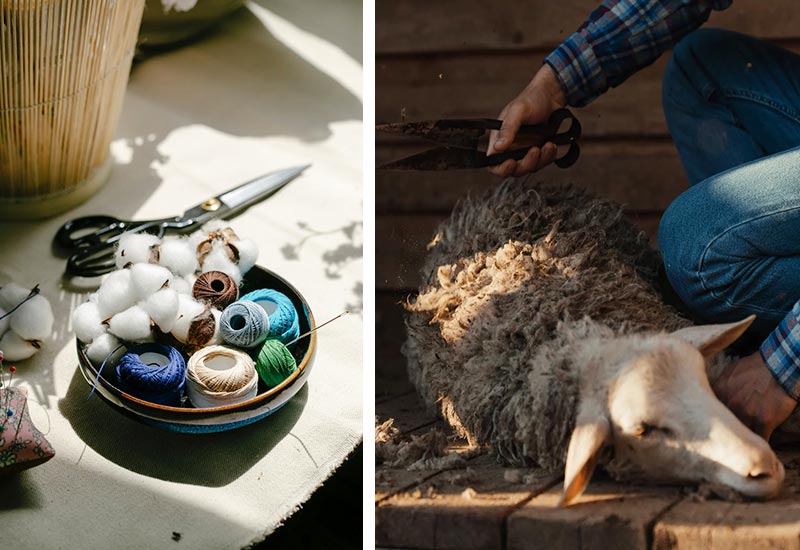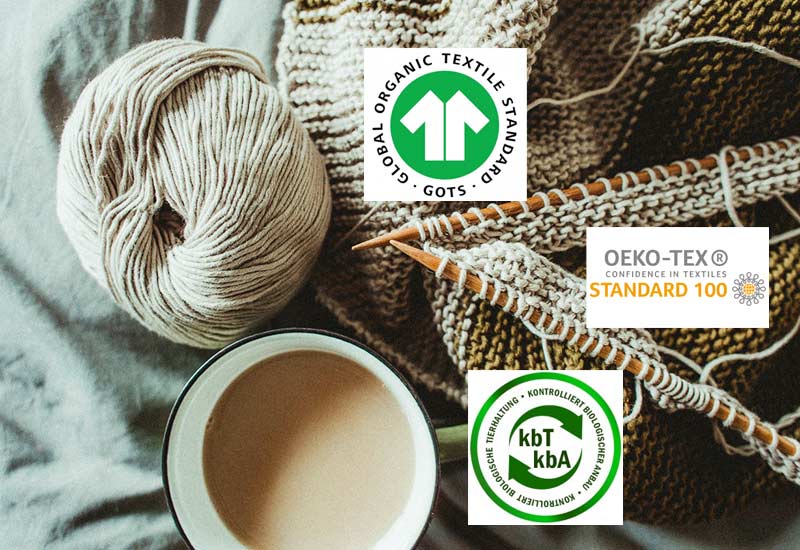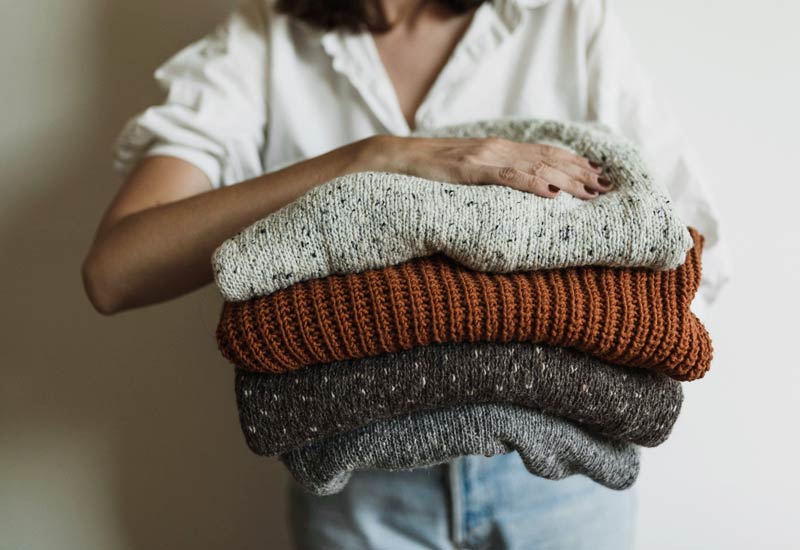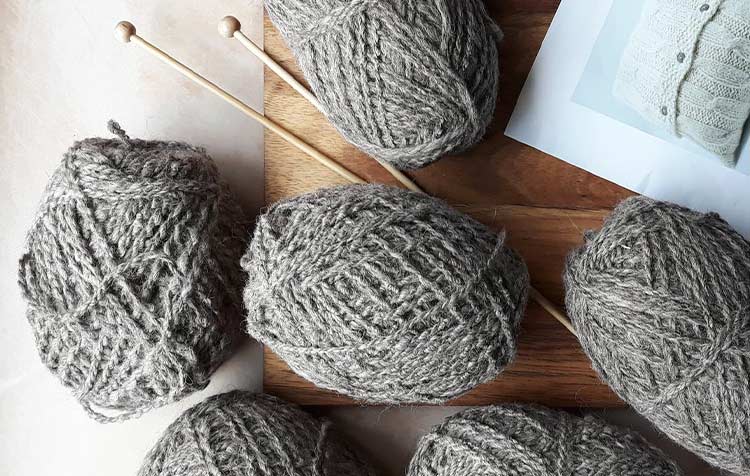What is sustainable wool - and how can you recognize it? From sweaters, blankets, scarves, gloves or hats, from crochet, knitting or macramé DIY, we all know how great and versatile the silky soft, hypoallergenic, elastic and breathable fabric is. But few can be sure whether the ball of wool in the wool store or the beautiful knitted sweater in the fashion store is really sustainable.
In this article, I would like to introduce you to everything you need to know about sustainable wool - from the motifs and tips for everyday life, to the characteristics by which you can recognize it. From sheep's wool to cotton. Let's go!
As always, you can find a brief overview here in advance:
Why prefer sustainable wool at all?

A wool product is sustainable first and foremost if it is fair, animal-friendly, produced with respect for resources and the environment will be as resistant, stable and durable and is not based on the expense of future generations.
In this regard, the following motifs (and probably many more) are decisive for most people to prefer the versatile, sustainable wool:
- Resource conservation
- Environment
- Animal Welfare
- Versatility
- Save money
- Justice
- Uncomplicated implementation
Sustainable consumption of wool is first and foremost about permanently protecting the planet on which we all live together. It's about not harming other people and animals. And about using high-quality, durable wool products and treating them well, save money sustainably, while not bending and limiting yourself as much as possible.
In the following, I would like to go into these aspects in a little more detail.
Reduce resource consumption
The Earth Overload Day (Earth Overshoot Day basically comes closer to the beginning of the year each year. This refers to the day in the year on which we humans have consumed more renewable resources than the Earth can reproduce in the entire year. So we live at the expense of nature - that can't go on forever.
Buying sustainable wool, for example, therefore consumes less natural resourcesbecause they do not have long Sea or air transport has behind it, because no animal is specially raised for this purpose and with cultivated Pet food had to be fed, or because no Energy in state-of-the-art greenhouses and no exorbitant Water quantities were consumed in warmer climes.
Prevent animal suffering
Whether from sheep, camels, rabbits, alpacas or the cashmere goat - many wool products are of animal origin and are combed out at regular intervals from animals specially bred and shorn for this purpose. There are also different types of wool. At Tear wool is understood, for example, recycled wool from waste wool. Tanner wool is obtained from slaughtered animals, whereas Death Wool is due to animals that died of natural causes.
Animals are seen more as a product in the wool industry, and less as a sentient being. Especially practices like the Mulesing are extremely controversial. This involves cutting out the skin of (merino) sheep around the tail to prevent infestation by flies in the dirty and poorly ventilated skin folds of the animals' genital areas. But in the industry, this is generally not for the love of animals, but for profit done.
By buying sustainable, mulesing-free or purely plant-based wool, you can accordingly also make a valuable Contribute to animal welfare.
Versatility
Of course, the origin and processing determine the quality of wool. But quite fundamentally it brings so many, useful advantages for us humans entails that we prefer the sustainable to the conventional counterpart, rather than a completely different alternative for wool.
For example, wool is not, as already mentioned at the beginning, soft, hypoallergenic, elastic and breathable, but also moisture regulating, flame retardant, wrinkle resistant, odor resistant, dirt-repellent and warming and also cooling depending on the ambient temperature. Of course, wool products are also very sensitive and susceptible to moths or hot water temperatures in the washing machine - but perhaps it is the appreciative care and knowledge of the origin of the material that make it so special.
Save money
After that headline, you're probably wondering how preferring sustainable wool can be easy on your wallet, right?
On the one hand, since sustainable wool is usually also high quality and durable is. Maybe the yarn or the wool sweater may cost a few euros more, however, you have with appropriate appreciation also very very long something of it.
On the other hand, however, for me the Proper treatment and care of the wool products play a big role. The longer you use them and can use them, the less resources you use, the less animal suffering you cause and the more money you save.
Protect environment
To prefer sustainable wool not only conserves natural resources, but also also protects the environment from harmful inputs. Apart from the fact that natural wool in contrast to Microplastic fibers biodegradable, organic wool is also used as much as possible. Ecologically produced. For example, there is usually no use of toxic substances in the cotton fields, in the production of animal feed and, last but not least, in the processing of the material.
Justice
Another advantage of fair and sustainable wool is that its purchase promotes a fairer coexistence for all people. Great importance is attached to ensuring that all those involved in the entire value chain of a wool product benefit from it - and that employees are appropriately fairly paid and health protected can work.
Tip: Did you know that you can also vegan for human rights can be? In the linked article I explain to you why I live vegan not only for animals but also for people.
Uncomplicated implementation
Before this goes down, there is a misconception among many people that sustainability has to be complicated and that one has to limit oneself. It also persists when it comes to wool, even though the implementation really super uncomplicated in practice Is. No one has to bend or give up anything when it comes to sustainable wool goods - but can still make a real difference.
In the following, I would now like to show you how you can recognize environmentally friendly, sustainable wool. So that more people renounce conventional wool and prefer sustainable wool, this information is really important.
How do I recognize sustainable wool?

The business community is not leaving us environmentally conscious and animal-loving consumers alone when it comes to wool. Many Seals, certifications, buzzwords like "organic", "recycled" and "vegan", "organic" or "eco", as well as the fabrics used give important hints, even if you should always look at them critically in general, to avoid possible Greenwashing not to support.
Here I would like to give you some trustworthy labels for sustainable wool to look out for when buying.
kbT and kbA
The protected abbreviations stand for "controlled organic animal husbandry" and "controlled organic cultivation". Corresponding products are subject to an extensive system of tests and specifications for the environmentally friendly organic cultivation of wool products or even the animal feed for sheep, as well as animal welfare in general.
NATURAL TEXTILE BEST
The International Association of the Natural Textile Industry e. V. has issued guidelines for natural textiles with regard to the ecological and social responsibility of their production throughout the entire supply chain. With this seal, you can recognize the most environmentally friendly production of woolen goods possible - from the targeted avoidance of waste and toxins, to the economical use of water and energy.
OekoTex Standard 100
This is a label for textiles tested for harmful substances. Even if animal welfare and resource conservation do not play a role in the awarding process, you can recognize wool products that have been tested for harmful substances and are harmless to health.
RWS
The Responsible Wool Standard lays down comprehensive rules for the Protection of animals in wool production firmly. From the feed to the hygiene to the ban on mulesing, we consumers can recognize animal-friendly and, above all, mulesing-free wool by this seal.
GOTS
The Global Organic Textile Standard recognizes Textiles based on natural fibers off. The assessment ranges from the process of textile extraction to the finished wool yarn or garment. GOTS-certified textiles, for example, have to be At least 70 percent from organically produced natural fibers exist.
What else can I do to make my wool as sustainable as possible?

Now you know how to recognize environmentally friendly and fair wool. But beyond the production and labeling, you can also make a stronger positive change in the wool industry.
Finally, here are some short tips I'd like to share with you:
Prefer plant-based alternatives
To avoid animal suffering and the avoidable waste of natural resources, you should choose wool that consists of plant-based fibers. Beautiful examples are Organic cotton, Lyocell (Tencel), hand or linen. This way you make sure you didn't have to put up with any animal suffering or death for consuming a wool product.
Buy used
An important piece of advice from the world of Slow Fashion Is to buy wool fashion used. So no sheep have to suffer for you and no new resources have to be consumed either. The dusty image of second-hand runs has long since become obsolete - consumer interest has migrated from identical, boring mass-produced items to special one-offs and a new appreciation for garments.
Pay attention to quality
A clean finish and sturdy material make your wool products even more more durableso you don't have to buy a new wool sweater soon and dispose of the old one. Just consume directly thinking long term, save money, natural resources and protect animals and the planet.
Wash as rarely as possible
Appreciate what you have. Wash wool products as rarely as possible, and when you do by hand, with special wool detergents or the wool wash cycle your washing machine. You can avoid unpleasant odors by airing your clothes in the fresh air or simply outside your closet. If you can't avoid washing in the washing machine, turn your clothes inside out to load the mechanical stress on the side that is invisible when worn.
Protect from damage
Keep your wool clothing in your sustainable closet by using natural fragrances, such as. Lavender or cedar, from moth infestation and other damage.
As a buyer, you are also responsible for reducing energy and water consumption, the cultivation of animal feed, and the costly processing, packaging and transport of animal feed. sustainably paid off have. After all, even a product made of organic wool is not sustainable, if it acts 2 weeks after the purchase already back in the trash can.
See and untie knots
If you find a knot, carefully remove it with a comb to prevent permanent damage. Otherwise, if you neglect the care, the sustainability of the wool will be gone pretty quickly.
Dry carefully
After washing your wool sweater should be pulled into shape Dry lying instead of hangingOtherwise, the force of gravity pulls him in the length. Just put a towel underneath that you then change - but definitely refrain from throwing your wool sweater into the stressful tumble dryer!
Prefer manufacturers with green philosophy
If you can no longer avoid a new purchase, you should prefer the brands, stores and manufacturers that you are sure about. Pay attention to the company philosophy and the public appearance of the responsible persons. Many companies sell only mulesing-free wool, organic wool or generally certified and strictly controlled wool.
Another advantage of this tip: If in a certain situation you find it too exhausting to pay attention to sustainability, then simply prefer the brands you can be absolutely sure of.
Can you think of any other tips for environmentally conscious, sustainable use of wool? Then feel free to write me a comment.
Prefer sustainable wool in the purchase decision
Terms like "pure cotton" or "100 percent pure wool" are supposed to make us consumers feel better, but they say absolutely nothing about how health-, animal-, social- or environmentally-friendly the products are. That's where we have to take a closer look when choosing wool yarns and garments.
In this article, you've learned what to look for - and that it's actually pretty simple and straightforward. I really hope that I could help you to be more aware of sustainable wool in the future.
Do you have any questions, tips or suggestions? Then I am looking forward to your comment under this article.
Stay sustainable,

PS.: How you Washing cotton correctlyso that you have something from it as long as possible, you will learn in the linked article. Have fun!





